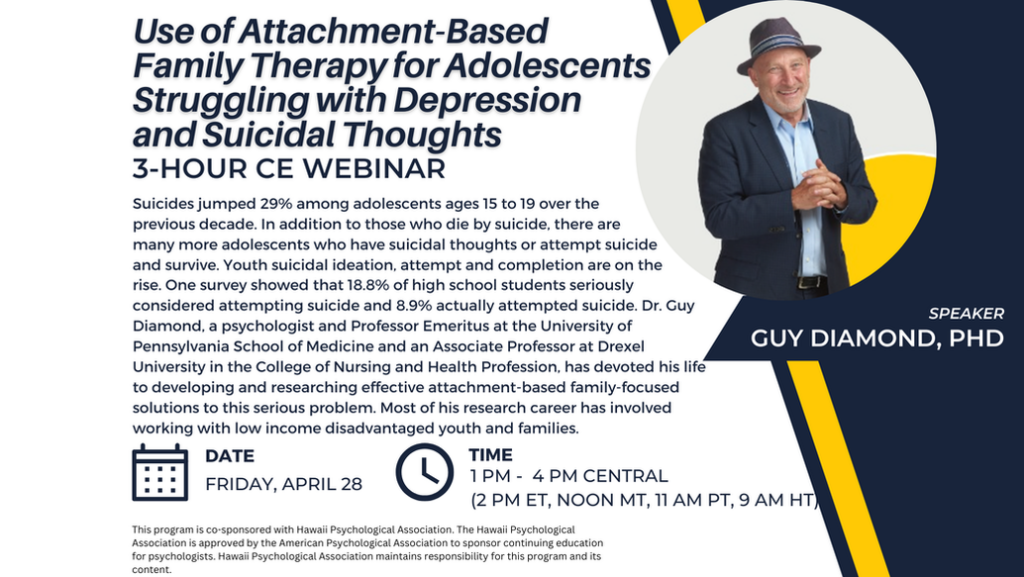ABFT Webinar

Title: “Use of Attachment-based Family Therapy for Adolescents Struggling with Depression and Suicidal Thoughts “
Format: Live On designated date
On-Demand options to follow
When: Friday, April 28, 2023
Description
ABFT is a brief, empirically supported family based treatment for depressed and suicidal adolescents. Most manualized family therapies target externalizing disorders and most manualized treatments for youth depression focus on CBT and medication. Thus, ABFT is the first family therapy model developed, tested and disseminated for adolescents with internalizing disorders. Sensitive to issues of cultural diversity and their impact on family functioning, the model is a trust-based, emotion-focused psychotherapy, yet builds on specific goals and tasks that provide treatment structure.
Four studies have demonstrated that ABFT can reduce adolescent suicide ideation (SI) and/or depression better than waitlist controls and/or treatment as usual (Diamond et al, 2002, 2003, 2010; Israel & Diamond, 2012). ABFT is even effective with the most severe youth presenting with comorbid anxiety, severe SI, history of multiple suicide attempts, and/or a history of sexual abuse. ABFT has been adapted for use with suicidal LGB adolescents (Diamond, et al., 2011) and used as a hospital aftercare program (Diamond, et al 2011). Over 15 process research studies have been conducted examining the mechanism of change in ABFT. ABFT has been reviewed by NREPP and was included on the NREPP website. The ABFT manual was published by APA (Diamond et al, 2014).
ABFT grows out of the clinical tradition of Structural/Multidimensional Family Therapy and Emotionally-focused therapy. Attachment theory however, provides the theoretical framework to understand and guide the clinical process. Rather than focus initially on symptom reduction, ABFT therapists assume that, for many adolescents, depression/suicide is a coping response to family or environmental stress. The quality of the parent-child relationship partially mediates adolescent capacity to manage these stressors. Treatment therefore, focuses on resolving family conflicts that have ruptured the secure base of the family. This helps reduce conflict and increases trust, but also provides emotionally charged in-vivo conversations for improving affect regulation and interpersonal problem solving. With attachment on the mend, treatment focuses on promoting the adolescent’s autonomy (e.g., behavioral cooperation at home, reintegration into school and social life, identify formation). Improved attachment security reestablishes the normative family context of adolescent development, which helps buffer against depression and suicide.
Although the therapy is trauma-focused, it is brief, structured, yet flexible. Treatment is characterized by five tasks: a)relational reframe, b) adolescent alliance, c) parent alliance, d) attachment and e) promoting autonomy. The Relational Reframe Task focuses the therapy on what prohibits the adolescent from going to his/her parent(s) when feeling depressed or suicidal. For some adolescents, this may be “big” traumas (e.g., neglect, abandonment, abuse) or “little,” but chronic, traumas such as intense conflict, divorce, or parental depression. Regardless, Task 1 aims to shift the initial goal of treatment from behavioral control or symptom reduction to resolving relational ruptures that inhibit trust and security.
The Adolescent Alliance Task with the adolescent alone helps the adolescent identify and articulate these relational traumas and how they contribute to the depression/SI. With this connection better understood, the therapist helps the adolescent prepare to talk with the parents about these ruptures.
Third, the Parent Alliance Task, aims to identify current stressors and inter-generational attachment injuries that might be impacting current parenting practices. As parents develop empathy for their own losses, they become more sensitive to their child’s attachment needs. Parents are then taught emotional coaching skills that will support the upcoming parent-adolescent conversations in the next task.
In the Attachment Task, the adolescent and parents are brought together to discuss the attachment ruptures. Therapists help the adolescent directly express, in an honest and vulnerable, yet emotionally regulated manner, feelings, thoughts and memories that drive anger or indifference, and that reinforce depression and/or suicide. The therapist helps parents acknowledge the adolescent experience and continue to express themselves. This emotionally honest dialogue provides a “corrective attachment experience” where adolescents seek understanding and support and parents provide comfort and attention.
Finally, the Autonomy Promoting Task builds on the emerging secure base of attachment and begins to focus on autonomy promotion. Conversations might address cooperation in the home, re-engagement in school and social life, and or identify development (e.g., race, sexual identity, etc.).
Using case studies, videos and discussion, this workshop will provide an overview of the theoretical principles, research support and clinical strategies of ABFT. We will review how attachment theory, emotional regulation, and trauma resolution inform the delivery of this experiential treatment approach. We will teach the five treatment tasks that provide a roadmap for delivering this interpersonally focused, depth psychotherapy, effectively and rapidly. Participants will learn how this model helps families repair interpersonal ruptures that have damaged trust and rebuild emotionally protective, secure parent–child relationships.
Course Objectives
At the conclusion of this course, participants will be able to:
1. Explain the theoretical foundation of ABFT that guides therapists in therapy implementation.
2. Discuss the purpose of the five treatment tasks.
3. Design therapy to focus on interpersonal growth rather than behavioral control
Presenter
Guy Diamond, PhD, is Professor Emeritus at the University of Pennsylvania School of Medicine and Associate Professor at Drexel University in the College of Nursing and Health Professions. At Drexel, he is the Director of the Center for Family Intervention Science (CFIS). Dr. Diamond is the primary developer of Attachment-Based Family Therapy (ABFT). He has received several federal, state and foundation grants to develop and test this model. His primary work has been in the area of youth suicide prevention and treatment research. On the prevention side, he has created a program focused on training, screening and triage to be implemented in non-behavioral health settings. On the treatment side, he has focused on the development and testing of attachment-based family therapy, especially for teens struggling with depression and suicide. Much of this work has focused on inner-city low-income families. He has served as the VP of Science for Division 43 of APA and has focused his efforts on increasing the visibility of the Division as a leader in Family Intervention Science in APA. He was a main stage presenter at APA’s 2022 convention. Along with his co-authors, Drs. Gary Diamond and Suzanne Levy, Dr. Diamond has written the first book on ABFT, “Attachment-Based Family Therapy for Depressed Adolescents,” published by the American Psychological Association. ABFT emerges from interpersonal theories that suggest adolescent depression and suicide can be precipitated, exacerbated, or buffered against by the quality of interpersonal relationships in families. ABFT aims to repair interpersonal ruptures and rebuild an emotionally protective, secure-based, parent child relationship. The treatment initially focuses on repairing or strengthening attachment and then turns to promoting adolescent autonomy.
Cost
LPA Student Member: $15
Non-LPA Student: $20
LPA Member: $30
Non-Member: $40
Registration opens Friday, March 10, 2023 at 4:00 PM CDT
